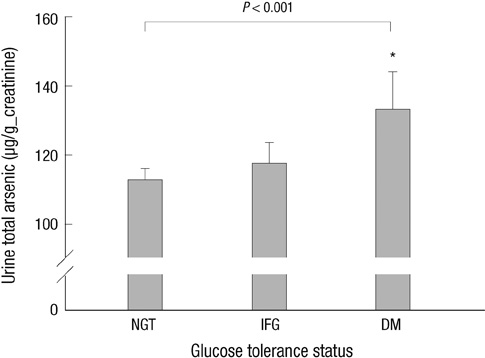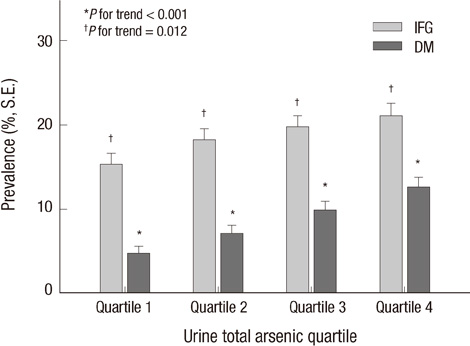J Korean Med Sci.
2013 Jun;28(6):861-868. 10.3346/jkms.2013.28.6.861.
Arsenic Exposure and Prevalence of Diabetes Mellitus in Korean Adults
- Affiliations
-
- 1Department of Endocrinology and Metabolism, Kyung Hee University School of Medicine, Seoul, Korea. jtwoomd@khmc.or.kr
- KMID: 2158033
- DOI: http://doi.org/10.3346/jkms.2013.28.6.861
Abstract
- It has been suggested that there is an association between environmental, low-level arsenic exposure and the risk of diabetes mellitus (DM), but little research has been conducted. Here, the glucose tolerance status and urinary creatinine adjusted total arsenic concentrations were analyzed in 3,602 subjects > or = 20 yr of age who were registered for the Korea National Health and Nutrition Examination Survey, 2008-2009. Various demographic parameters were associated with urinary arsenic concentrations. After adjusting for these variables, urinary arsenic concentrations in subjects with DM were significantly higher than those in subjects with normal glucose tolerance and those with impaired fasting glucose (P < 0.001). Compared with the lowest quartile ( < 70.7 microg/g creatinine), the odds ratios and 95% confidence intervals for DM were 1.11 (0.73-1.68), 1.42 (0.94-2.13), and 1.56 (1.03-2.36) for urinary arsenic concentrations of 70.7 to < 117.7, 117.7 to < 193.4, and > or = 193.4 microg/g creatinine, respectively, following multivariate adjustment. Furthermore, the urinary total arsenic concentration was inversely associated with the insulin secretion index, HOMA2 %B (beta = -0.033, P = 0.032). These findings suggest that arsenic exposure, possibly involving beta cell dysfunction, is associated with an increased risk of DM in the Korean population.
Keyword
MeSH Terms
-
Adult
Alcohol Drinking
Arsenic/*urine
Asian Continental Ancestry Group
Blood Glucose/analysis
Diabetes Mellitus/*epidemiology/etiology
Female
Glucose Tolerance Test
Humans
Insulin/metabolism
Insulin Resistance
Male
Middle Aged
Nutrition Surveys
Odds Ratio
Prevalence
Republic of Korea/epidemiology
Risk Factors
Smoking
Blood Glucose
Insulin
Arsenic
Figure
Reference
-
1. Lai MS, Hsueh YM, Chen CJ, Shyu MP, Chen SY, Kuo TL, Wu MM, Tai TY. Ingested inorganic arsenic and prevalence of diabetes mellitus. Am J Epidemiol. 1994. 139:484–492.2. Rahman M, Tondel M, Ahmad SA, Axelson O. Diabetes mellitus associated with arsenic exposure in Bangladesh. Am J Epidemiol. 1998. 148:198–203.3. Coronado-González JA, Del Razo LM, García-Vargas G, Sanmiguel-Salazar F, Escobedo-de la Peña. Inorganic arsenic exposure and type 2 diabetes mellitus in Mexico. Environ Res. 2007. 104:383–389.4. Jensen GE, Hansen ML. Occupational arsenic exposure and glycosylated haemoglobin. Analyst. 1998. 123:77–80.5. Navas-Acien A, Silbergeld EK, Streeter RA, Clark JM, Burke TA, Guallar E. Arsenic exposure and type 2 diabetes: a systematic review of the experimental and epidemiological evidence. Environ Health Perspect. 2006. 114:641–648.6. Chen CJ, Wang SL, Chiou JM, Tseng CH, Chiou HY, Hsueh YM, Chen SY, Wu MM, Lai MS. Arsenic and diabetes and hypertension in human populations: a review. Toxicol Appl Pharmacol. 2007. 222:298–304.7. Navas-Acien A, Silbergeld EK, Pastor-Barriuso R, Guallar E. Arsenic exposure and prevalence of type 2 diabetes in US adults. JAMA. 2008. 300:814–822.8. Longnecker MP, Daniels JL. Environmental contaminants as etiologic factors for diabetes. Environ Health Perspect. 2001. 109:871–876.9. Ruiz-Navarro ML, Navarro-Alarcón M, Lopez González-de la Serrana H, Pérez-Valero V, López-Martinez MC. Urine arsenic concentrations in healthy adults as indicators of environmental contamination: relation with some pathologies. Sci Total Environ. 1998. 216:55–61.10. Lamm SH, Engel A, Feinleib M. Arsenic exposure and diabetes mellitus risk. J Occup Environ Med. 2006. 48:1001–1003.11. Zierold KM, Knobeloch L, Anderson H. Prevalence of chronic diseases in adults exposed to arsenic-contaminated drinking water. Am J Public Health. 2004. 94:1936–1937.12. Wang SL, Chang FH, Liou SH, Wang HJ, Li WF, Hsieh DP. Inorganic arsenic exposure and its relation to metabolic syndrome in an industrial area of Taiwan. Environ Int. 2007. 33:805–811.13. Chen Y, Ahsan H, Slavkovich V, Peltier GL, Gluskin RT, Parvez F, Liu X, Graziano JH. No association between arsenic exposure from drinking water and diabetes mellitus: a cross-sectional study in Bangladesh. Environ Health Perspect. 2010. 118:1299–1305.14. Ministry of Health & Welfare. 2008 National Health Statistics. accessed on 28 December 2012. Available at http://knhanes.cdc.go.kr/knhanes/index.do.15. Ministry of Health & Welfare. 2009 National Health Statistics. accessed on 28 December 2012. Available at http://knhanes.cdc.go.kr/knhanes/index.do.16. Kim Y, Lee BK. Association between urinary arsenic and diabetes mellitus in the Korean general population according to KNHANES 2008. Sci Total Environ. 2011. 409:4054–4062.17. Park HS, Park CY, Oh SW, Yoo HJ. Prevalence of obesity and metabolic syndrome in Korean adults. Obes Rev. 2008. 9:104–107.18. International Standard Classification of Occupations. The International Standard Classification of Occupations 2008. accessed on 28 December 2012. Available at http://www.ilo.org/public/english/bureau/stat/isco/isco08/index.htm.19. Statistics Korea. 6th Korean Standard Statistical Classification of Occupations. accessed on 28 September 2012. Available at http://kostat.go.kr/kssc/main/MainAction.do?method=sub&catgrp=ekssc&catid1=ekssc02&catid2=ekssc02a.20. American Diabetes Association. Diagnosis and classification of diabetes mellitus. Diabetes Care. 2011. 34:S62–S69.21. Levy JC, Matthews DR, Hermans MP. Correct homeostasis model assessment (HOMA) evaluation uses the computer program. Diabetes Care. 1998. 21:2191–2192.22. Wallace TM, Levy JC, Matthews DR. Use and abuse of HOMA modeling. Diabetes Care. 2004. 27:1487–1495.23. Bland JM, Altman DG. Transformations, means, and confidence intervals. BMJ. 1996. 312:1079.24. Yan LL, Liu K, Matthews KA, Daviglus ML, Ferguson TF, Kiefe CI. Psychosocial factors and risk of hypertension: the Coronary Artery Risk Development in Young Adults (CARDIA) Study. JAMA. 2003. 290:2138–2148.25. Aposhian HV, Aposhian MM. Arsenic toxicology: five questions. Chem Res Toxicol. 2006. 19:1–15.26. Sabbioni E, Fischbach M, Pozzi G, Pietra R, Gallorini M, Piette JL. Cellular retention, toxicity and carcinogenic potential of seafood arsenic: I. lack of cytotoxicity and transforming activity of arsenobetaine in the BALB/3T3 cell line. Carcinogenesis. 1991. 12:1287–1291.27. Cleland B, Tsuchiya A, Kalman DA, Dills R, Burbacher TM, White JW, Faustman EM, Mariën K. Arsenic exposure within the Korean community (United States) based on dietary behavior and arsenic levels in hair, urine, air, and water. Environ Health Perspect. 2009. 117:632–638.28. Cascio C, Raab A, Jenkins RO, Feldmann J, Meharg AA, Haris PI. The impact of a rice based diet on urinary arsenic. J Environ Monit. 2011. 13:257–265.29. Mandal BK, Suzuki KT. Arsenic round the world: a review. Talanta. 2002. 58:201–235.30. Nisianakis P, Giannenas I, Gavriil A, Kontopidis G, Kyriazakis I. Variation in trace element contents among chicken, turkey, duck, goose, and pigeon eggs analyzed by inductively coupled plasma mass spectrometry (ICP-MS). Biol Trace Elem Res. 2009. 128:62–71.31. Walton FS, Harmon AW, Paul DS, Drobná Z, Patel YM, Styblo M. Inhibition of insulin-dependent glucose uptake by trivalent arsenicals: possible mechanism of arsenic-induced diabetes. Toxicol Appl Pharmacol. 2004. 198:424–433.32. Díaz-Villaseñor A, Sánchez-Soto MC, Cebrián ME, Ostrosky-Wegman P, Hiriart M. Sodium arsenite impairs insulin secretion and transcription in pancreatic beta-cells. Toxicol Appl Pharmacol. 2006. 214:30–34.
- Full Text Links
- Actions
-
Cited
- CITED
-
- Close
- Share
- Similar articles
-
- Association of Diabetes Mellitus with a Combination of Vitamin D Deficiency and Arsenic Exposure in the Korean General Population: Analysis of 2008-2009 Korean National Health and Nutrition Examination Survey Data
- Health Effects of Chronic Arsenic Exposure
- Prevalence and Risk Factors for Diabetes Mellitus and Impaired Fasting Glucose of Adults
- Intervention Strategies for Older Adults with Diabetes
- Posttransplant Diabetes Mellitus



